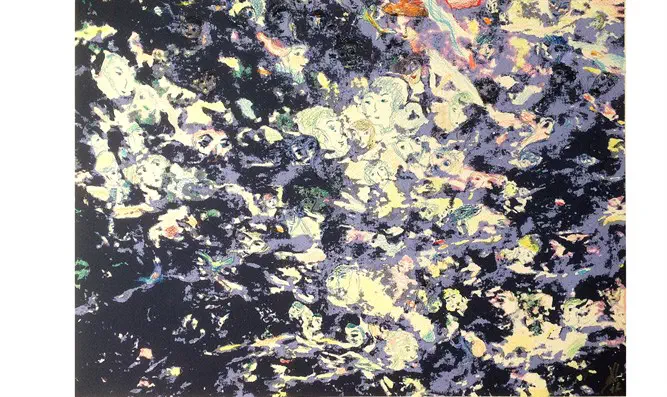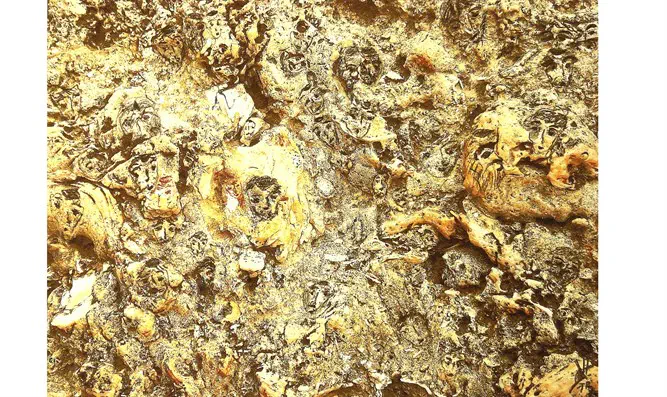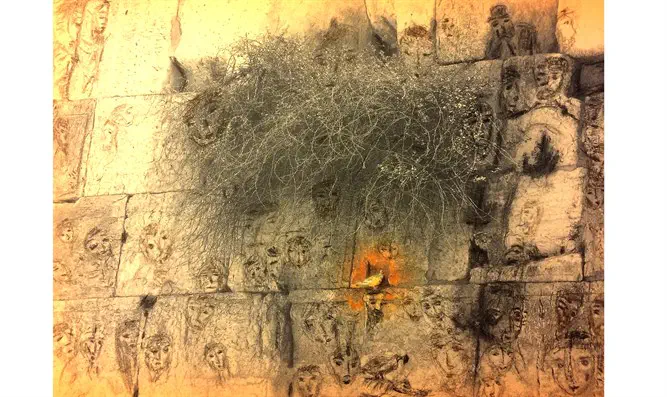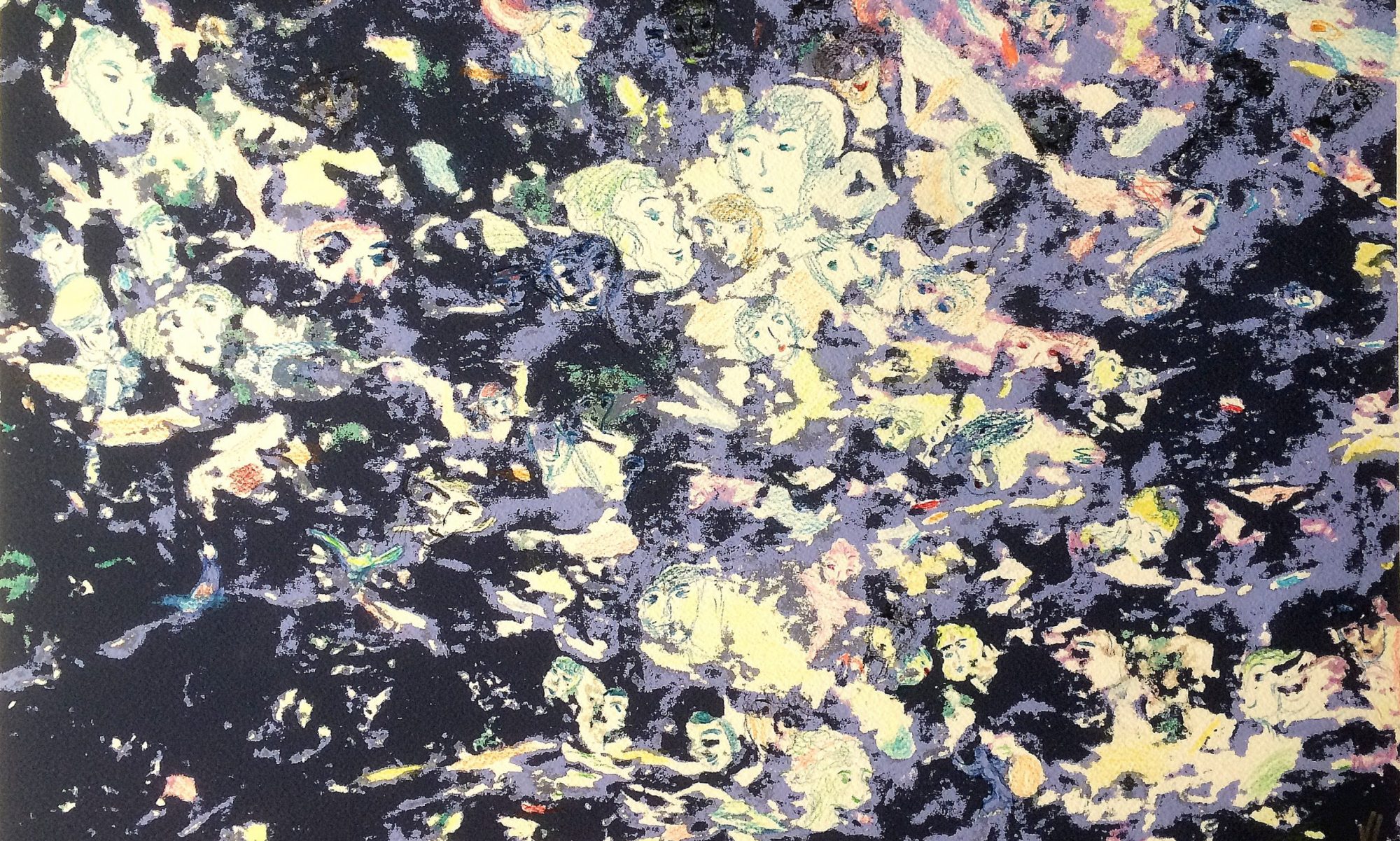
Remembrance is an essential part of humanity, a lifeline, literally, for those who are gone and those who are living and remember.
First published: The Israel National News, 18 September 2020
What is the memory dimension in contemporary art? And yet more specifically, in contemporary Jewish art? We can have a look on its sources and genesis via a special art series called Songs of Our Souls that I have been creating from 2017 onward.
The artworks in the series were not planned as such. The idea to develop them into the series arose after the first work in this technique had been created.
The work was in homage to Rabbi Nachman of Breslov and at the same time, it is also a tribute to the Jewish people as a whole. Arutz Sheva published the work at the time.
Since then, Songs of Our Souls has become a sizable series comprising 20 works, and the number is growing. Some of it is presented in this essay.
Living Memory
When memory is living and functioning, not only do we add more depth to our words but we uplift our own lives, our level of existence – if only because we are re-activating and bringing back the energy of people who are gone.
Those people who appeared in my works have lived and passed away under so different circumstances. It happened throughout the layers of the past. They were here, in this world, they were laughing, crying, thinking, speaking. They had their thoughts and hopes. In the reflective time of a Jewish year closing, and a new one to emerge soon, it is fitting to think about them all, with a hope that perhaps, somebody one day will remember some of us, too.
Remembrance is an essential part of humanity. It is a lifeline, literally, for both those who are gone and those who are living and remember.
My Cloud View work represents the idea of the Songs of Our Souls well. It paints the space around us with images of people who are appearing there in our memory and imagination. Inna Rogatchi (C). Cloud View. 2020.I. Rogatchi
Inna Rogatchi (C). Cloud View. 2020.I. Rogatchi
Surprise Messages from Above
In all of the many works that I have created in this technique, not a single face did I draw without seeing it first, the face’s own appearance transpiring from a template prepared for drawings. As the series grew, more and more faces began appearing out for me to draw them, in the works on different subjects, from the Kotel to the Shoah, and from prayers to history.
In this work dedicated to remembrance of the strength of Jewish spirit exemplified at Masada, the stones of Israel are full of the imprints of numerous Jewish faces, young and old, men, women and children. They all are here. It only takes an effort to see them around us. Inna Rogatchi (C). Masada I. 2020.I. Rogatchi
Inna Rogatchi (C). Masada I. 2020.I. Rogatchi
Similar sensations were experienced by me when I was working on the pieces originated from and connected with the Kotel.
As I was contemplating over the drawings, all of the sudden, time stopped. The faces started to appear from a known template. It was happening on almost every stone of the Kotel which I know so very well, and which is arguably the most important place on this earth for me.
It is difficult to verbalise the feeling of gratitude that overwhelmed me at that moment.
Similar sensations were experienced by me when I was working on the pieces originated from and connected with the Kotel.
As I was contemplating over the drawings, all of the sudden, time stopped. The faces started to appear from a known template. It was happening on almost every stone of the Kotel which I know so very well, and which is arguably the most important place on this earth for me.
It is difficult to verbalise the feeling of gratitude that overwhelmed me at that moment.https://fc301cd7062b06c4859509020d5fecfa.safeframe.googlesyndication.com/safeframe/1-0-37/html/container.html
I was thinking of devoted Jews coming to the Kotel under any circumstances and despite all the risk involved, from the time the courtyard of the Second Temple was extended by Herod and until the establishment of the State of Israel, all those two thousand, two hundred and twenty years.
I was thinking of the Jews who were unable to come to the Kotel while seeing it so close, during the twenty years of Jordanian control between 1948 and 1967.
I was thinking of the horrific days and nights back in 70 CE when our Second Temple was burned by the Romans in a tectonic catastrophe for Jewry and Judaism, with only these 50 meters of the Kotel surviving. How lonely and terrified those stones must have been at the time. But what a strength the Kotel bears, becoming the ultimate source of ultimate strength to so many generations from 70 CE onward. Inna Rogatchi (C). The Kotel and Its Faces. 2020I. Rogatchi
Inna Rogatchi (C). The Kotel and Its Faces. 2020I. Rogatchi
Prayer Hours
The other work concentrated on prayer and Kotel is dedicated to dear friend, special artist and great humanist, late Pat Mercer Hutchens, brave author of the unique Re-Visiting Auschwitz project.
When I started to work on it, the faces emerged from the Kotel wall on the template. The first time I produced the previous edition of the work for my Shining Souls project back in 2016, there were no faces. It travelled to the world being shown at several exhibitions, without them. Now the faces appeared. I was only happy to draw them with respect and love.
Inna Rogatchi ©. Prayer Hour II. 2020.
Ghetto Stories, Living Faces
Initially, one of my works from the Ghetto Waltz collection selected for the exhibition in Italy, was also without faces. But a short while after, when I started to work on it for the exhibition, to send it to Rome, these faces were there. I just had no courage to ignore them. Especially on the subject of the Shoah.
I do believe that it is important to be distinct in our memory on the Shoah. The more distinct, the better. What else can we do for them, after all?
Inna Rogatchi ©. Crying Heaven. 2019.
The similar thinking and idea is transparent in another work which is about our Jewish memory, Ebbing, Tiding ( 2018). The title echoes the waves of our memory reflecting on our history, with its ebbing and tiding that interconnects us each to each other.
When our memory, our instrument for survival, is materialized, it arms us with endurance. The whole ofJewish history is the story of our endurance. Sometimes, it appears to us in pictures.
In my understanding, that is the chance to remember our history in a more tangible way, and to make our memory a living one.



 Inna Rogatchi(C). Challenges. Questions & Answers. Crayons Luminance, oil pastel on authored original archival print on cotton paper. 30 x 40 cm. 2020. Hidden Windows series. Private collection, London, the UK.
Inna Rogatchi(C). Challenges. Questions & Answers. Crayons Luminance, oil pastel on authored original archival print on cotton paper. 30 x 40 cm. 2020. Hidden Windows series. Private collection, London, the UK. Inna Rogatchi (C). Lifeline I. Lapice pastel, crayons Luminance, oil pastel on authored original archival print on cotton paper. 40 x 30 cm. 2020. Tree of Sparks series.
Inna Rogatchi (C). Lifeline I. Lapice pastel, crayons Luminance, oil pastel on authored original archival print on cotton paper. 40 x 30 cm. 2020. Tree of Sparks series. Inna Rogatchi (C). Balance Between Good and Evil. Crayons Luminance, lapice pastel on authored original archival print on cotton paper. Tree of Sparks series. 2020.
Inna Rogatchi (C). Balance Between Good and Evil. Crayons Luminance, lapice pastel on authored original archival print on cotton paper. Tree of Sparks series. 2020. Inna Rogatchi (C). Balance Between Good and Evil. Fragment 2. 2020.
Inna Rogatchi (C). Balance Between Good and Evil. Fragment 2. 2020. Inna Rogatchi (C). Contraction II. Oil pastel, lapice pastel, crayons Luminance on authored original archival print on cotton Museum Velin 315 mg paper. 33 x 48 cm. Tree of Sparks series. 2019.
Inna Rogatchi (C). Contraction II. Oil pastel, lapice pastel, crayons Luminance on authored original archival print on cotton Museum Velin 315 mg paper. 33 x 48 cm. Tree of Sparks series. 2019. Inna Rogatchi (C). Contraction II. Fragment 1. 2019.
Inna Rogatchi (C). Contraction II. Fragment 1. 2019. Inna Rogatchi (C). Memory Wind II. Ol pastel, wax pastel, watercolor, lapice pastel, crayons Luminance on authored original archival print on cotton paper. Tree of Sparks series. 30 x 40 cm. 2020.
Inna Rogatchi (C). Memory Wind II. Ol pastel, wax pastel, watercolor, lapice pastel, crayons Luminance on authored original archival print on cotton paper. Tree of Sparks series. 30 x 40 cm. 2020. Inna Rogatchi (C). Memory Wind II. Fragment V. 2020.
Inna Rogatchi (C). Memory Wind II. Fragment V. 2020. Inna Rogatchi (C). Life of Sparks II. Watercolor, oil pastel, wax pastel, lapice pastel, crayons Luminance on authored original archival print on cotton Museum Velin 315 mg paper. 33 x 48 cm. Tree of Sparks series. 2019.
Inna Rogatchi (C). Life of Sparks II. Watercolor, oil pastel, wax pastel, lapice pastel, crayons Luminance on authored original archival print on cotton Museum Velin 315 mg paper. 33 x 48 cm. Tree of Sparks series. 2019. Inna Rogatchi (C). Life of Sparks II. Fragment 2. 2019.
Inna Rogatchi (C). Life of Sparks II. Fragment 2. 2019. Inna Rogatchi (C). Beauty of Understanding. Watercolor, oil pastel on authored original archival print on cotton paper. 40 x 30 cm. 2020. Tree of Sparks series.
Inna Rogatchi (C). Beauty of Understanding. Watercolor, oil pastel on authored original archival print on cotton paper. 40 x 30 cm. 2020. Tree of Sparks series. Inna Rogatchi (C). Soul’s Quest. Watercolor, oil pastel, lapice pastel, crayons Luminance on authored original archival print on cotton Museum Velin 315 mg paper. 33 x 48 cm. 2020.
Inna Rogatchi (C). Soul’s Quest. Watercolor, oil pastel, lapice pastel, crayons Luminance on authored original archival print on cotton Museum Velin 315 mg paper. 33 x 48 cm. 2020. Inna Rogatchi (C). Soul’s Quest. Fragment. 2020.
Inna Rogatchi (C). Soul’s Quest. Fragment. 2020.

 Inna Rogatchi (C). The Shavuot Night Trilogy. Triptych. Part 1. The Window. Watercolour, crayons a encre on original archival print on cotton paper. 80 x 100 cm. Jewish Mysticism: Artistic Views series. 2018-2019
Inna Rogatchi (C). The Shavuot Night Trilogy. Triptych. Part 1. The Window. Watercolour, crayons a encre on original archival print on cotton paper. 80 x 100 cm. Jewish Mysticism: Artistic Views series. 2018-2019 Inna Rogatchi (C). The Shavuot Night Trilogy. Triptych. Part 2. Transition. Crayons a encre on original archival print on cotton paper. 80 x 100 cm. 2018-2019. Jewish Mysticism: Artistic View series
Inna Rogatchi (C). The Shavuot Night Trilogy. Triptych. Part 2. Transition. Crayons a encre on original archival print on cotton paper. 80 x 100 cm. 2018-2019. Jewish Mysticism: Artistic View series Inna Rogatchi (C). The Shavuot Night Trilogy. Triptych. Part 3. Memories. Silver, pigment of aluminium on original archival print on cotton paper. 80 x 100 cm. 2018-2019. Jewish Mysticism: Artistic View.
Inna Rogatchi (C). The Shavuot Night Trilogy. Triptych. Part 3. Memories. Silver, pigment of aluminium on original archival print on cotton paper. 80 x 100 cm. 2018-2019. Jewish Mysticism: Artistic View.
 Inna Rogatchi (C). This Kind of Forest. Fine Art Photography. Limited Edition. Black Milk & Dark Stars series. 2014.
Inna Rogatchi (C). This Kind of Forest. Fine Art Photography. Limited Edition. Black Milk & Dark Stars series. 2014.